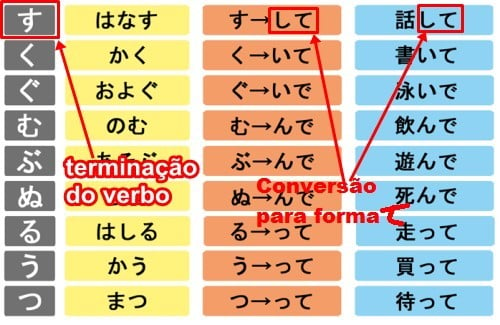TE (て) is one of the most fundamental forms in Japanese. Those who are starting to learn Japanese may have already come across the て (te). For those who haven't reached that point yet, the て (TE) form is used to conjugate verbs, make requests, and list actions performed in the same sentence.
Therefore, I will explain from now on how this form works in the Japanese language. Check out:
Table of Content
1. Form "te" (て) - To make a request
First of all, this form is used to ask someone for something informally. To use this form, what you need to do is change the verb ending to the て form. A basic example: Let's use the verb 食べる (taberu) which means "to eat". The verb ending is る. Therefore, in the て form, it would be 食べて (tabete) which means "eat".
However, depending on the verb ending, you will not place exactly て in its place. Below is a list of how to use this form:

2. Form "te" (て) - For verb conjugation
This form is also used to conjugate verbs in the present continuous tense. It indicates that the person is currently performing an action.
To conjugate, combine the て form + いる as shown in the table below:
| Kanji (romaji) | Meaning | Form て + いる | Meaning |
|---|---|---|---|
| する (suru) | Verb to do | している (shiteiru) | Doing |
| くる (kuru) | Verb to come | きている (kiteiru) | Coming |
| 飲む (nomu) | Verb to drink | 飲んでいる | Drinking |
| 遊ぶ (asobu) | Verb to play | 遊んでいる (asondeiru) | Playing |
| 杀す (korosu) | Verb to kill | 殺している (koroshiteiru) | Killing |
| 聞く (kiku) | Verb listen | 闻いている (kiiteiru) | Listening |
In summary, you will use the て form and add いる to the verb you are conjugating;
3. The "te" form (て) - To connect words
Likewise, this form can also be used to connect words. However, て is used to connect only verbs. For example, let's use the following sentences:
今日は起きてました
Kyou wa okitemashita
Today, I got up
朝ご飯を食べました
Asagohan wo tabemashita
I had breakfast.
学校に行きました
Gakkou ni ikimashita
I went to school
How will we connect these sentences? It's simple. Using the て form, the three sentences look like this:
今日は起きて、朝ご飯を食べて、学校に行きました。
kyou wa okite, asagohan wo tabete, gakkou ni ikimashita
Today I got up, had breakfast, and went to school.
Thus, the three sentences are connected to each other to establish a chronological order of events. However, only the last verb remains in the polite form (forma ます). If you are going to write a sentence in the polite form, always leave the last verb in the forma ます.
